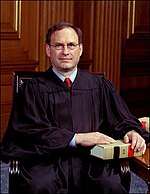| Type | Case | Citation | Issues | Joined by | Other opinions |
|---|
101
| NASA v. Nelson | 562 U.S. 134 (2011)
| background check of prospective federal employees • informational privacy • Privacy Act of 1974 | Roberts, Kennedy, Ginsburg, Breyer, Sotomayor | |
|
202
| Staub v. Proctor Hospital | 562 U.S. 411 (2011)
| Uniformed Services Employment and Reemployment Rights Act of 1994 • influence of prior discrimination on subsequent decisionmaker | Thomas | |
|
103
| Henderson v. Shinseki | 562 U.S. 428 (2011)
| Veterans' Judicial Review Act • Court of Appeals for Veterans Claims • excusability of missing deadline for filing appeal | Roberts, Scalia, Kennedy, Thomas, Ginsburg, Breyer, Sotomayor | |
|
404
| Snyder v. Phelps | 562 U.S. 443 (2011)
| First Amendment • free speech • intentional infliction of emotional distress | | |
|
305
| Pepper v. United States | 562 U.S. 476 (2011)
| Federal Sentencing Guidelines • consideration of postsentencing rehabilitation | | |
|
106
| Wall v. Kholi | 562 U.S. 545 (2011)
| Antiterrorism and Effective Death Penalty Act of 1996 • tolling of habeas corpus statute of limitations • motion to reduce sentence as application for collateral review | Roberts, Kennedy, Thomas, Ginsburg, Breyer, Sotomayor, Kagan; Scalia (in part) | |
|
207
| Milner v. Department of Navy | 562 U.S. 562 (2011)
| Freedom of Information Act • exemption for internal personnel rules | | |
|
408
| Wong v. Smith • [ full text ] | 562 U.S. 1021 (2010)
| judicial commenting on evidence • judicial coercion of a jury verdict | Roberts, Scalia | |
| Alito filed a dissent from the Court's denial of certiorari, where the lower court had granted habeas relief on the grounds that a judge's comments to a deadlocked jury about the evidence coerced them into returning a guilty verdict. Alito observed that the privilege of common law judges to comment on the evidence was centuries old, and no Supreme Court precedent had yet ruled on whether or when the exercise of that privilege constituted coercion. In Alito's view, therefore, the lower court's judgment was contrary to the requirement under the Antiterrorism and Effective Death Penalty Act that a state court judgment must be contrary to clearly established law in order to be set aside by a federal habeas court. |
409
| Harper v. Maverick Recording Co. • [ full text ] | 562 U.S. 1080 (2010)
| copyright infringement • statutory damages • innocent infringer defense • music downloading | | |
| Alito filed a dissent from the Court's denial of certiorari, in a case involving a 16-year-old girl sued for illegally downloading music from the internet. The lower court had ruled the girl was ineligible for the "innocent infringer" defense, which would have reduced the statutory damages available, because it was foreclosed by 17 U.S.C. § 402(d), which applies when the defendant had access to a "phonorecord" bearing a copyright notice. Alito noted that the statutory definition of "phonorecord" only applied to material objects, and so there was a "strong argument" that §402(d) did not apply to downloaded digital music files. Though there was not yet a circuit split on the issue, Alito believed certiorari was appropriate because the issue was important and unlikely to be presented to the courts of appeals in many cases. |
510
| Huber v. New Jersey Dept. of Environmental Protection | 562 U.S. 1302 (2011)
| Fourth Amendment • warrantless searches • wetlands protection | Roberts, Scalia, Thomas | |
| Alito filed a statement respecting the Court's denial of certiorari. |
211
| Cullen v. Pinholster | 563 U.S. 170 (2011)
| Antiterrorism and Effective Death Penalty Act of 1996 • introduction of new evidence in habeas corpus proceedings • Sixth Amendment • ineffective assistance of counsel | | |
|
112
| Kentucky v. King | 563 U.S. 452 (2011)
| Fourth Amendment • exigent circumstances • police-created exigency | Roberts, Scalia, Kennedy, Thomas, Breyer, Sotomayor, Kagan | |
|
413
| Brown v. Plata | 563 U.S. 493 (2011)
| Prison Litigation Reform Act of 1995 • Eighth Amendment • prison overcrowding | Roberts | |
|
414
| Fowler v. United States | 563 U.S. 668 (2011)
| federal witness tampering crime • likelihood victim was intending to communicate with federal officer | Ginsburg | |
|
115
| Global-Tech Appliances, Inc. v. SEB S. A. | 563 U.S. 754 (2011)
| patent law • induced infringement • willful blindness | Roberts, Scalia, Thomas, Ginsburg, Breyer, Sotomayor, Kagan | |
|
216
| Nevada Comm'n on Ethics v. Carrigan | 564 U.S. 117 (2011)
| vote recusal of state legislator with conflict of interest • First Amendment • overbreadth doctrine | | |
|
117
| United States v. Jicarilla Apache Nation | 564 U.S. 162 (2011)
| fiduciary exception to attorney–client privilege • general trust relationship between the United States and Indian tribes | Roberts, Scalia, Kennedy, Thomas | |
|
118
| Davis v. United States | 564 U.S. 229 (2011)
| Fourth Amendment • exclusionary rule • good faith reliance on binding appellate precedent | Roberts, Scalia, Kennedy, Thomas, Kagan | |
|
419
| J. D. B. v. North Carolina | 564 U.S. 261 (2011)
| Fifth Amendment • Miranda warning • effect of minor's age on determining custodial status | Roberts, Scalia, Thomas | |
|
220
| American Elec. Power Co. v. Connecticut | 564 U.S. 410 (2011)
| Clean Air Act • power plant carbon dioxide emissions standards • federal common law nuisance claims | Thomas | |
|
221
| Brown v. Entertainment Merchants Assn. | 564 U.S. 786 (2011)
| First Amendment • freedom of speech • restriction on sale of violent video games to minors | Roberts | |
|

